Liza ramada Juveniles after Exposure to the Toxic Dinoflagellate Vulcanodinium rugosum: Effects on Fish Viability, Tissue Contamination and Microalgae Survival after Gut Passage
Abstract
1. Introduction
2. Results
2.1. L. ramada Ability to Ingest V. rugosum Cells
2.2. V. rugosum Feeding Induced L. ramada Tissues Contamination
2.3. Lack of V. rugosum Effect on Fish Viability
2.4. V. rugosum Temporary Cysts Germinated after Gut Passage
3. Discussion
3.1. Liza ramada Potential to Be a Vector of Vulcanodinium rugosum Toxins
3.2. Liza ramada Potential to Disseminate Vulcanodinium rugosum Cells
4. Conclusions
5. Materials and Methods
5.1. Dinoflagellate Culture
5.2. Collection and Maintenance of Juvenile Fish Samples
5.3. Feeding Experiments
5.4. Fish Mortality Monitoring
5.5. Viability of Microalgae Cells after Gut Passage
5.5.1. Fecal Material Composition
5.5.2. Germination of Microalgae Temporary Cysts
5.6. Toxins Analyses
5.6.1. Extraction from Microalgae Strains
5.6.2. Extraction from the Fish
5.6.3. Identification and Quantification of Toxins
5.7. Data Treatment and Statistical Analysis
Author Contributions
Funding
Institutional Review Board Statement
Data Availability Statement
Acknowledgments
Conflicts of Interest
References
- Smayda, T.J. Harmful Algal Blooms: Their Ecophysiology and General Relevance to Phytoplankton Blooms in the Sea. Limnol. Oceanogr. 1997, 42, P1137–P1153. [Google Scholar] [CrossRef]
- Glibert, P.M. Harmful algae at the complex nexus of eutrophication and climate change. Harmful Algae 2020, 91, 101583. [Google Scholar] [CrossRef] [PubMed]
- Gobler, C.J. Climate Change and Harmful Algal Blooms: Insights and perspective. Harmful Algae 2020, 91, 101731. [Google Scholar] [CrossRef] [PubMed]
- Nehring, S. Non-indigenous phytoplankton species in the North Sea: Supposed region of origin and possible transport vector. Arch. Fish. Mar. Res. 1998, 46, 181–194. [Google Scholar]
- Bolch, C.J.S.; de Salas, M.F. A review of the molecular evidence for ballast water introduction of the toxic dinoflagellates Gymnodinium catenatum and the Alexandrium tamarensis complex to Australasia. Harmful Algae 2007, 6, 465–485. [Google Scholar] [CrossRef]
- Garrett, M.J.; Puchulutegui, C.; Selwood, A.I.; Wolny, J.L. Identification of the harmful dinoflagellate Vulcanodinium rugosum recovered from a ballast tank of a globally traveled ship in Port Tampa Bay, Florida, USA. Harmful Algae 2014, 39, 202–209. [Google Scholar] [CrossRef]
- Scarratt, A.M.; Scarratt, D.J.; Scarratt, M.G. Survival of live Alexandrium tamarense cells in mussel and scallop spat under simulated transfer conditions. J. Shellfish Res. 1993, 12, 383–388. [Google Scholar]
- Shumway, S.E.; Allen, S.M.; Dee Boersma, P. Marine birds and harmful algal blooms: Sporadic victims or under-reported events? Harmful Algae 2003, 2, 1–7. [Google Scholar] [CrossRef]
- Alves, T.; Mafra, L. Diel Variations in Cell Abundance and Trophic Transfer of Diarrheic Toxins during a Massive Dinophysis Bloom in Southern Brazil. Toxins 2018, 10, 232. [Google Scholar] [CrossRef]
- Choi, M.-C.; Yu, P.K.N.; Hsieh, D.P.H.; Lam, P.K.S. Trophic transfer of paralytic shellfish toxins from clams (Ruditapes philippinarum) to gastropods (Nassarius festivus). Chemosphere 2006, 64, 1642–1649. [Google Scholar] [CrossRef]
- Karjalainen, M.; Reinikainen, M.; Spoof, L.; Meriluoto, J.A.O.; Sivonen, K.; Viitasalo, M. Trophic transfer of cyanobacterial toxins from zooplankton to planktivores: Consequences for pike larvae and mysid shrimps. Environ. Toxicol. 2005, 20, 354–362. [Google Scholar] [CrossRef] [PubMed]
- Botana, L.M.; Alfonso, A. Phycotoxins: Chemistry and Biochemistry; John Wiley & Sons: Hoboken, NJ, USA, 2015; pp. 23–68. [Google Scholar]
- Nézan, E.; Chomérat, N. Vulcanodinium rugosum gen. et sp. nov. (Dinophyceae), un Nouveau Dinoflagellé Marin de la Côte Méditerranéenne Française. Cryptogam. Algol. 2011, 32, 3–18. [Google Scholar] [CrossRef]
- Abadie, E. Etude de Vulcanodinium rugosum (Dinoflagellé Producteur de Pinnatoxines) se Développant Dans la Lagune Méditerranéenne de l’Ingril. Doctoral Dissertation, Université de Montpellier, Montpellier, France, 2015. Available online: https://archimer.ifremer.fr/doc/00473/58425/ (accessed on 17 May 2022).
- Delcourt, N.; Lagrange, E.; Abadie, E.; Labadie, M.; Sinno-Tellier, S.; Bloch, J.; Arnich, N.; Molgó, J.; de Haro, L.; Mattei, C. Pinnatoxines: Évaluation des risques et toxicovigilance. Toxicol. Anal. Clin. 2021, 33, 25. [Google Scholar] [CrossRef]
- Munday, R.; Selwood, A.I.; Rhodes, L. Acute toxicity of pinnatoxins E, F and G to mice. Toxicon 2012, 60, 995–999. [Google Scholar] [CrossRef] [PubMed]
- Selwood, A.I.; Wilkins, A.L.; Munday, R.; Shi, F.; Rhodes, L.L.; Holland, P.T. Portimine: A bioactive metabolite from the benthic dinoflagellate Vulcanodinium Rugosum. Tetrahedron Lett. 2013, 54, 4705–4707. [Google Scholar] [CrossRef]
- Moreira-González, A.R.; Comas-González, A.; Valle-Pombrol, A.; Seisdedo-Losa, M.; Hernández-Leyva, O.; Fernandes, L.F.; Chomérat, N.; Bilien, G.; Hervé, F.; Rovillon, G.A.; et al. Summer bloom of Vulcanodinium rugosum in Cienfuegos Bay (Cuba) associated to dermatitis in swimmers. Sci. Total Environ. 2021, 757, 143782. [Google Scholar] [CrossRef]
- Rhodes, L.; Smith, K.; Selwood, A.; Mcnabb, P.; Munday, R.; Suda, S.; Molenaar, S.; Hallegraeff, G. Dinoflagellate Vulcanodinium rugosum identified as the causative organism of pinnatoxins in Australia, New Zealand and Japan. Phycologia 2011, 50, 624–628. [Google Scholar] [CrossRef]
- Selwood, A.I.; Wilkins, A.L.; Munday, R.; Gu, H.F.; Smith, K.F.; Rhodes, L.L.; Rise, F. Pinnatoxin H: A new pinnatoxin analogue from a South China Sea Vulcanodinium rugosum isolate. Tetrahedron Lett. 2014, 55, 5508–5510. [Google Scholar] [CrossRef]
- Smith, K.F.; Rhodes, L.L.; Suda, S.; Selwood, A.I. A dinoflagellate producer of pinnatoxin G, isolated from sub-tropical Japanese waters. Harmful Algae 2011, 10, 702–705. [Google Scholar] [CrossRef]
- Almeida, P.R. Feeding ecology of Liza ramada (Risso, 1810) (Pisces, Mugilidae) in a south-western estuary of Portugal. Estuar. Coast. Shelf Sci. 2003, 57, 313–323. [Google Scholar] [CrossRef]
- Laffaille, P.; Feunteun, E.; Lefebvre, C.; Radureau, A.; Sagan, G.; Lefeuvre, J.C. Can Thin-lipped Mullet Directly Exploit the Primary and Detritic Production of European Macrotidal Salt Marshes? Estuar. Coast. Shelf Sci. 2002, 54, 729–736. [Google Scholar] [CrossRef]
- Lebreton, B.; Richard, P.; Parlier, E.P.; Guillou, G.; Blanchard, G.F. Trophic ecology of mullets during their spring migration in a European saltmarsh: A stable isotope study. Estuar. Coast. Shelf Sci. 2011, 91, 502–510. [Google Scholar] [CrossRef][Green Version]
- Cardona, L. Food and Feeding of Mugilidae. In Biology, Ecology and Culture of Grey Mullets (Mugilidae); Crosetti, D., Blaber, S.J.M., Eds.; CRC Press: Boca Raton, FL, USA, 2015. [Google Scholar]
- Stewart, I.; Eaglesham, G.J.; McGregor, G.B.; Chong, R.; Seawright, A.A.; Wickramasinghe, W.A.; Sadler, R.; Hunt, L.; Graham, G. First Report of a Toxic Nodularia spumigena (Nostocales/Cyanobacteria) Bloom in Sub-Tropical Australia. II. Bioaccumulation of Nodularin in Isolated Populations of Mullet (Mugilidae). Int. J. Environ. Res. Public. Health 2012, 9, 2412–2443. [Google Scholar] [CrossRef]
- Biagianti-Risbourg, S.; Bastide, J. Hepatic perturbations induced by a herbicide (atrazine) in juvenile grey mullet Liza ramada (Mugilidae, Teleostei): An ultrastructural study. Aquat. Toxicol. 1995, 31, 217–229. [Google Scholar] [CrossRef]
- Chouba, L.; Kraiem, M.; Njimi, W.; Tissaoui, C.H.; Thompson, J.R.; Flower, R.J. Seasonal variation of heavy metals (Cd, Pb and Hg) in sediments and in mullet, Mugil cephalus (Mugilidae), from the Ghar El Melh Lagoon (Tunisia). Transit. Waters Bull. 2007, 1, 45–52. [Google Scholar] [CrossRef]
- Taylor, D.; Maddock, B.G.; Mance, G. The acute toxicity of nine ‘grey list’ metals (arsenic, boron, chromium, copper, lead, nickel, tin, vanadium and zinc) to two marine fish species: Dab (Limanda limanda) and grey mullet (Chelon labrosus). Aquat. Toxicol. 1985, 7, 135–144. [Google Scholar] [CrossRef]
- Vasconcelos, V. Cyanobacteria toxins: Diversity and ecological effects. Limnetica 2001, 20. [Google Scholar] [CrossRef]
- Ben-Gigirey, B.; Rossignoli, A.E.; Riobó, P.; Rodríguez, F. First Report of Paralytic Shellfish Toxins in Marine Invertebrates and Fish in Spain. Toxins 2020, 12, 723. [Google Scholar] [CrossRef]
- Woofter, R.T.; Brendtro, K.; Ramsdell, J.S. Uptake and Elimination of Brevetoxin in Blood of Striped Mullet (Mugil cephalus) after Aqueous Exposure to Karenia brevis. Environ. Health Perspect. 2005, 113, 11–16. [Google Scholar] [CrossRef]
- Rochard, E.; Elie, P. La macrofaune aquatique de l’estuaire de la Gironde: Contribution au livre blanc de l’Agence de l’eau Adour Garonne. In Etat des Connaissances sur l’estuaire de la Gironde; Agence de l’Eau Adour Garonne: Toulouse, France, 1994; p. 56. Available online: https://hal.inrae.fr/hal-02582433 (accessed on 17 May 2022).
- Pasquaud, S.; Girardin, M.; Elie, P. Diet of gobies of the genus Pomatoschistus (P. microps and P. minutus), in the Gironde estuary (France). Cybium Int. J. Ichthyol. 2014, 28, 99–106. [Google Scholar] [CrossRef]
- Barnabé, G. Exposé Synoptique des Données Biologiques sur le Loup ou Bar: Dicentrarchus Labrax (Linné, 1758); Org. des Nations Unies pour l’Alimentaion et l’Agriculture: Rome, Italy, 1980; p. 34. [Google Scholar]
- Lassus, P.; Marcaillou-Le Baut, C. Contamination, Transformation et détoxification des Produits Marins, in Toxines D’algues Dans L’alimentation; Frémy, J.-M., Lassus, P., Eds.; IFREMER: Brest, France, 2001; pp. 403–446. [Google Scholar]
- Bourquard, C.; Benharrat, K. La colonisation des lagunes du Golfe du Lion par les stades jeunes de Soleidae, Mugilidae et Sparidae, 1985. In Actes du 110e Congrès National des Sociétés Savantes; Comité des travaux historiques et scientifiques: Paris, France, 1985; pp. 127–138. [Google Scholar]
- Bauder, A.G.; Cembella, A.D. Viability of the toxic dinoflagellate Prorocentrum lima following ingestion and gut passage in the bay scallop Argopecten irradians. J. Shellfish Res. 2000, 19, 321–324. [Google Scholar]
- Guéguen, M.; Lassus, P.; Laabir, M.; Bardouil, M.; Baron, R.; Séchet, V.; Truquet, P.; Amzil, Z.; Barillé, L. Gut passage times in two bivalve molluscs fed toxic microalgae: Alexandrium minutum, A. catenella and Pseudo-nitzschia calliantha. Aquat. Living Resour. 2008, 21, 21–29. [Google Scholar] [CrossRef]
- Carriker, M.R. Introductions and transfers of molluscs: Risk consideration and implications. In Molluscan Introductions and Transfers; Carlton, J.T., Rosenfield, A., Eds.; Maryland Sea Grant College: Maryland, USA, 1994; pp. 21–24. [Google Scholar]
- Laabir, M.; Gentien, P. Survival of toxic dinoflagellates after gut passage in the Pacific oyster Crassostrea gigas Thunburg. J. Shellfish Res. 1999, 18, 217–222. [Google Scholar]
- Görgényi, J.; Boros, G.; Vitál, Z.; Mozsár, A.; Várbíró, G.; Vasas, G.; Borics, G. The role of filter-feeding Asian carps in algal dispersion. Hydrobiologia 2016, 764, 115–126. [Google Scholar] [CrossRef]
- Corriere, M.; Baptista, M.; Paula, J.R.; Repolho, T.; Rosa, R.; Reis Costa, P.; Soliño, L. Impaired fish swimming performance following dietary exposure to the marine phycotoxin okadaic acid. Toxicon 2020, 179, 53–59. [Google Scholar] [CrossRef]
- Souid, G.; Souayed, N.; Haouas, Z.; Maaroufi, K. Does the phycotoxin Okadaic acid cause oxidative stress damages and histological alterations to seabream (Sparus aurata)? Toxicon 2018, 144, 55–60. [Google Scholar] [CrossRef]
- Neves, R.A.F.; Nascimento, S.M.; Santos, L.N. Sublethal fish responses to short-term food chain transfer of DSP toxins: The role of somatic condition. J. Exp. Mar. Biol. Ecol. 2020, 524, 151317. [Google Scholar] [CrossRef]
- Ajuzie, C.C. Toxic Prorocentrum lima induces abnormal behaviour in juvenile sea bass. J. Appl. Phycol. 2008, 20, 19–27. [Google Scholar] [CrossRef]
- Corriere, M.; Soliño, L.; Costa, P.R. Effects of the Marine Biotoxins Okadaic Acid and Dinophysistoxins on Fish. J. Mar. Sci. Eng. 2021, 9, 293. [Google Scholar] [CrossRef]
- Nogueira, I.; Lobo-da-Cunha, A.; Afonso, A.; Rivera, S.; Azevedo, J.; Monteiro, R.; Cervantes, R.; Gago-Martinez, A.; Vasconcelos, V. Toxic Effects of Domoic Acid in the Seabream Sparus aurata. Mar. Drugs 2010, 8, 2721–2732. [Google Scholar] [CrossRef]
- Lefebvre, K.A.; Dovel, S.L.; Silver, M.W. Tissue distribution and neurotoxic effects of domoic acid in a prominent vector species, the northern anchovy Engraulis mordax. Mar. Biol. 2001, 138, 693–700. [Google Scholar] [CrossRef]
- Hardy, R.W.; Scott, T.M.; Hatfield, C.L.; Barnett, H.J.; Gauglitz, E.J.; Wekell, J.C.; Eklund, M.W. Domoic acid in rainbow trout (Oncorhynchus mykiss) feeds. Aquaculture 1995, 131, 253–260. [Google Scholar] [CrossRef]
- Bakke, M.J.; Hustoft, H.K.; Horsberg, T.E. Subclinical effects of saxitoxin and domoic acid on aggressive behaviour and monoaminergic turnover in rainbow trout (Oncorhynchus mykiss). Aquat. Toxicol. 2010, 99, 1–9. [Google Scholar] [CrossRef] [PubMed]
- Silva de Assis, H.C.; da Silva, C.A.; Oba, E.T.; Pamplona, J.H.; Mela, M.; Doria, H.B.; Guiloski, I.C.; Ramsdorf, W.; Cestari, M.M. Hematologic and hepatic responses of the freshwater fish Hoplias malabaricus after saxitoxin exposure. Toxicon 2013, 66, 25–30. [Google Scholar] [CrossRef] [PubMed]
- Lefebvre, K.; Silver, M.; Coale, S.L.; Tjeerdema, R. Domoic acid in planktivorous fish in relation to toxic Pseudo-nitzschia cell densities. Mar. Biol. 2002, 140, 625–631. [Google Scholar] [CrossRef]
- We, O. Utilization of the Direct Grazing and Plant Detritus Food Chains by the Striped Mullet Mugil cephalus. 1968. Available online: https://agris.fao.org/agris-search/search.do?recordID=XF2016004266 (accessed on 17 May 2022).
- Waltham, N.J.; Teasdale, P.R.; Connolly, R.M. Use of flathead mullet (Mugil cephalus) in coastal biomonitor studies: Review and recommendations for future studies. Mar. Pollut. Bull. 2013, 69, 195–205. [Google Scholar] [CrossRef] [PubMed]
- Lewis, R. Fish cutaneous mucus: A new source of skin surface lipid. Lipids 2006, 5, 947–949. [Google Scholar] [CrossRef]
- REPHY dataset—French Observation and Monitoring program for Phytoplankton and Hydrology in coastal waters. In Metropolitan Data; SEANOE: Issy-les-Moulineaux, France, 2021. [CrossRef]
- Abadie, E.; Muguet, A.; Berteaux, T.; Chomérat, N.; Hess, P.; Roque D’OrbCastel, E.; Masseret, E.; Laabir, M. Toxin and Growth Responses of the Neurotoxic Dinoflagellate Vulcanodinium rugosum to Varying Temperature and Salinity. Toxins 2016, 8, 136. [Google Scholar] [CrossRef]
- Abadie, E.; Kaci, L.; Berteaux, T.; Hess, P.; Sechet, V.; Masseret, E.; Rolland, J.; Laabir, M. Effect of Nitrate, Ammonium and Urea on Growth and Pinnatoxin G Production of Vulcanodinium rugosum. Mar. Drugs 2015, 13, 5642–5656. [Google Scholar] [CrossRef]
- Philipp, H.; Abadie, E.; Hervé, F.; Berteaux, T.; Séchet, V.; Aráoz, R.; Molgó, J.; Zakarian, A.; Sibat, M.; Rundberget, T.; et al. Pinnatoxin G is responsible for atypical toxicity in mussels (Mytilus galloprovincialis) and clams (Venerupis decussata) from Ingril, a French Mediterranean lagoon. Toxicon 2013, 75, 16–26. [Google Scholar] [CrossRef]
- Hichem Kara, M.; Quignard, J.P. Les Poissons des Lagunes et des Estuaires de Méditerranée; ISTE Editions Ltd.: Londres, UK, 2018; Volume 1, pp. 121–127. [Google Scholar]
- Ortiz-Zarragoitia, M.; Bizarro, C.; Rojo-Bartolomé, I.; de Cerio, O.; Cajaraville, M.; Cancio, I. Mugilid Fish Are Sentinels of Exposure to Endocrine Disrupting Compounds in Coastal and Estuarine Environments. Mar. Drugs 2014, 12, 4756–4782. [Google Scholar] [CrossRef] [PubMed]
- Cambrony, M. Identification et périodicité du recrutement des juvéniles de Mugilidae dans les littoraux du Languedoc-Roussillon. Vie MilieuLife Environ. 1984, 34, 221–227. [Google Scholar]
- Faucher, K.; Lagardère, J.-P.; Aubert, A. Quantitative Aspects of the Spatial Distribution and Morphological Characteristics of the Sea Bass (Dicentrarchus labrax L.; Teleostei, Serranidae) Trunk Lateral Line Neuromasts. Brain. Behav. Evol. 2005, 65, 231–243. [Google Scholar] [CrossRef] [PubMed]
- Pollux, B.J.A. The experimental study of seed dispersal by fish (ichthyochory). Freshw. Biol. 2011, 56, 197–212. [Google Scholar] [CrossRef]
- Moriarty, D.J.W. The physiology of digestion of blue-green algae in the cichlid fish. Tilapia Nilotica J. Zool. 1973, 171, 25–39. [Google Scholar] [CrossRef]
- Moriarty, C.M.; Moriarty, D.J.W. Quantitative estimation of the daily ingestion of phytoplankton by Tilapia nilotica and Haplochromis nigripinnis in Lake George, Uganda. J. Zool. 1973, 171, 15–23. [Google Scholar] [CrossRef]
- Miura, T.; Wang, J. Chlorophyll a found in feces of phytoplanktivorous cyprinids and its photosynthetic activity. SIL Proc. 1985, 22, 2636–2642. [Google Scholar] [CrossRef]
- Vörös, L.; Oldal, I.; Présing, M.; Balogh, K.V. Size-Selective Filtration and Taxon-Specific Digestion of Plankton Algae by Silver Carp (Hypophthalmichthys molitrix Val.), in Shallow Lakes ’95: Trophic Cascades in Shallow Freshwater and Brackish Lakes; Kufel, L.L., Prejs, A., Rybak, J.I., Eds.; Springer: Dordrecht, The Netherlands, 1997; pp. 223–228. [Google Scholar] [CrossRef]
- Datta (Saha), S.; Jana, B.B. Control of bloom in a tropical lake: Grazing efficiency of some herbivorous fishes. J. Fish Biol. 1998, 53, 12–24. [Google Scholar] [CrossRef]
- Lewin, W.-C.; Kamjunke, N.; Mehner, T. Phosphorus uptake by Microcystis during passage through fish guts. Limnol. Oceanogr. 2003, 48, 2392–2396. [Google Scholar] [CrossRef]
- Pollux, B.; Jong, M.; Steegh, A.; Ouborg, N.; van Groenendael, J.; Klaassen, M. The effect of seed morphology on the potential dispersal of aquatic macrophytes by the Common Carp (Cyprinus carpio). Freshw. Biol. 2006, 51, 2063–2071. [Google Scholar] [CrossRef]
- Agami, M.; Waisel, Y. The role of fish in distribution and germination of seeds of the submerged macrophytes Najas marina L. and Ruppia maritima L. Oecologia 1988, 76, 83–88. [Google Scholar] [CrossRef] [PubMed]
- Anderson, J.T.; Saldaña Rojas, J.; Flecker, A.S. High-quality seed dispersal by fruit-eating fishes in Amazonian floodplain habitats. Oecologia 2009, 161, 279–290. [Google Scholar] [CrossRef] [PubMed]
- Jančula, D.; Míkovcová, M.; Adámek, Z.; Maršálek, B. Changes in the photosynthetic activity of Microcystis colonies after gut passage through Nile tilapia (Oreochromis niloticus) and silver carp (Hypophthalmichthys molitrix). Aquac. Res. 2008, 39, 311–314. [Google Scholar] [CrossRef]
- Lopes, V.M.; Costa, P.R.; Rosa, R. Effects of Harmful Algal Bloom Toxin on Marine Organisms. In Ecotoxicology of Marine Organisms; Duarte, B., Caçador, I., Eds.; CRC Press: Boca Raton, FL, USA, 2019. [Google Scholar]
- Solino, L.; Reis Costa, P. Differential toxin profiles of ciguatoxins in marine organisms: Chemistry, fate and global distribution. Toxicon 2018, 150, 124–143. [Google Scholar] [CrossRef] [PubMed]
- Tsukamoto, K. Oceanic migration and spawning of anguillid eels. J. Fish Biol. 2009, 74, 1833–1852. [Google Scholar] [CrossRef]
- Tsukamoto, K.; Aoyama, J.; Miller, M.J. Migration, speciation, and the evolution of diadromy in anguillid eels. Can. J. Fish. Aquat. Sci. 2002, 59, 1989–1998. [Google Scholar] [CrossRef]
- Bardonnet, A.; Riera, P. Feeding of glass eels (Anguilla anguilla) in the course of their estuarine migration: New insights from stable isotope analysis. Estuar. Coast. Shelf Sci. 2005, 63, 201–209. [Google Scholar] [CrossRef]
- Chrisafi, E.; Kaspiris, P.; Katselis, G. Feeding habits of sand smelt (Atherina boyeri, Risso 1810) in Trichonis Lake (Western Greece). J. Appl. Ichthyol. 2007, 23, 209–214. [Google Scholar] [CrossRef]
- Harrison, P.J.; Waters, R.E.; Taylor, F.J.R. A broad-spectrum artificial seawater medium for coastal and open ocean phytoplankton. J. Phycol. 1980, 16, 28–35. [Google Scholar] [CrossRef]
- Fagín, E.; Bravo, I.; Garrido, J.L.; Rodríguez, F.; Figueroa, R.I. Scrippsiella acuminata versus Scrippsiella ramonii: A Physiological Comparison. Cytometry A 2019, 95, 985–996. [Google Scholar] [CrossRef]
- R Core Team. R: A Language and Environment for Statistical Computing; R Foundation for Statistical Computing: Vienna, Austria, 2020; Available online: https://www.r-project.org/ (accessed on 17 May 2022).
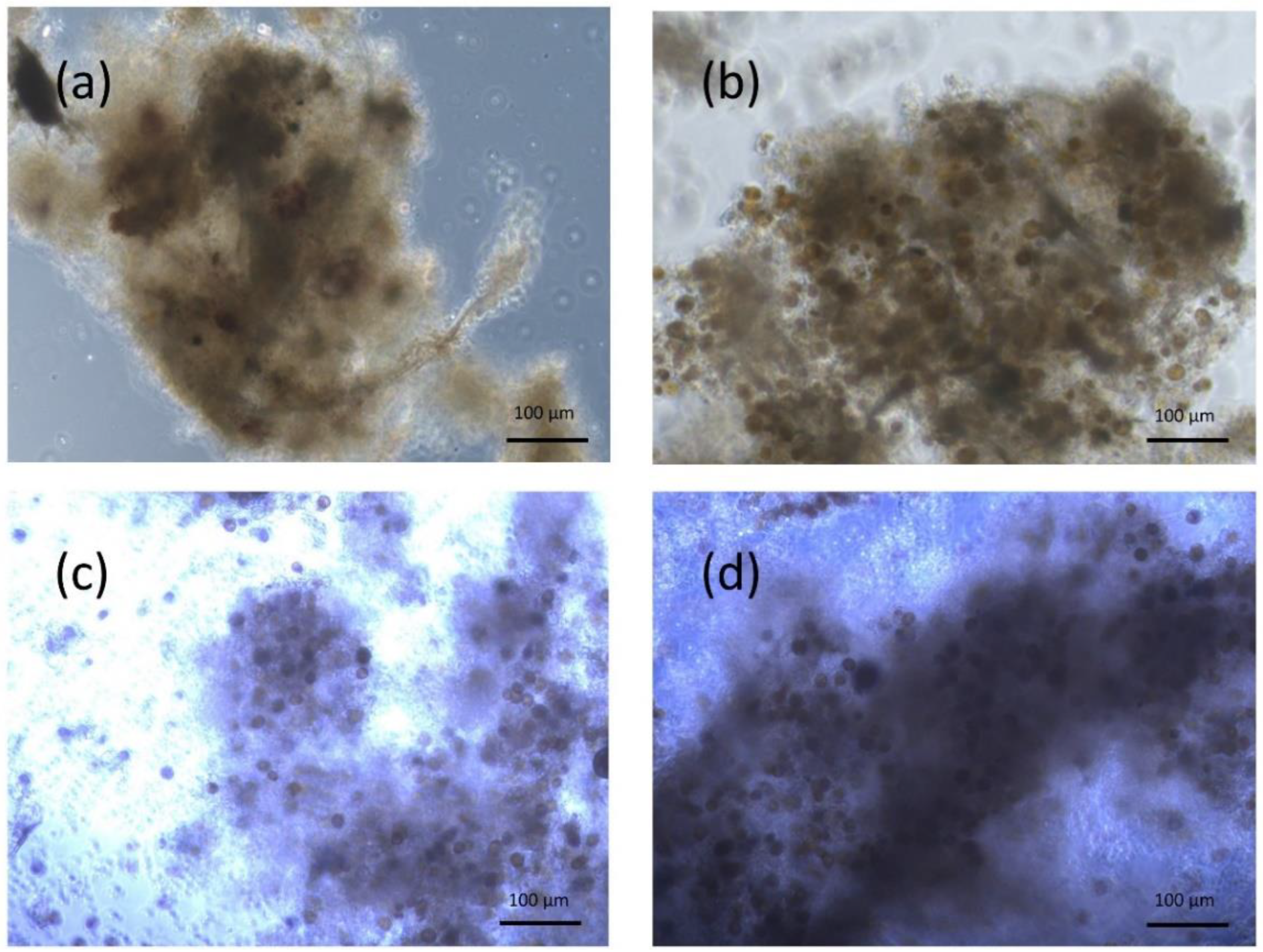
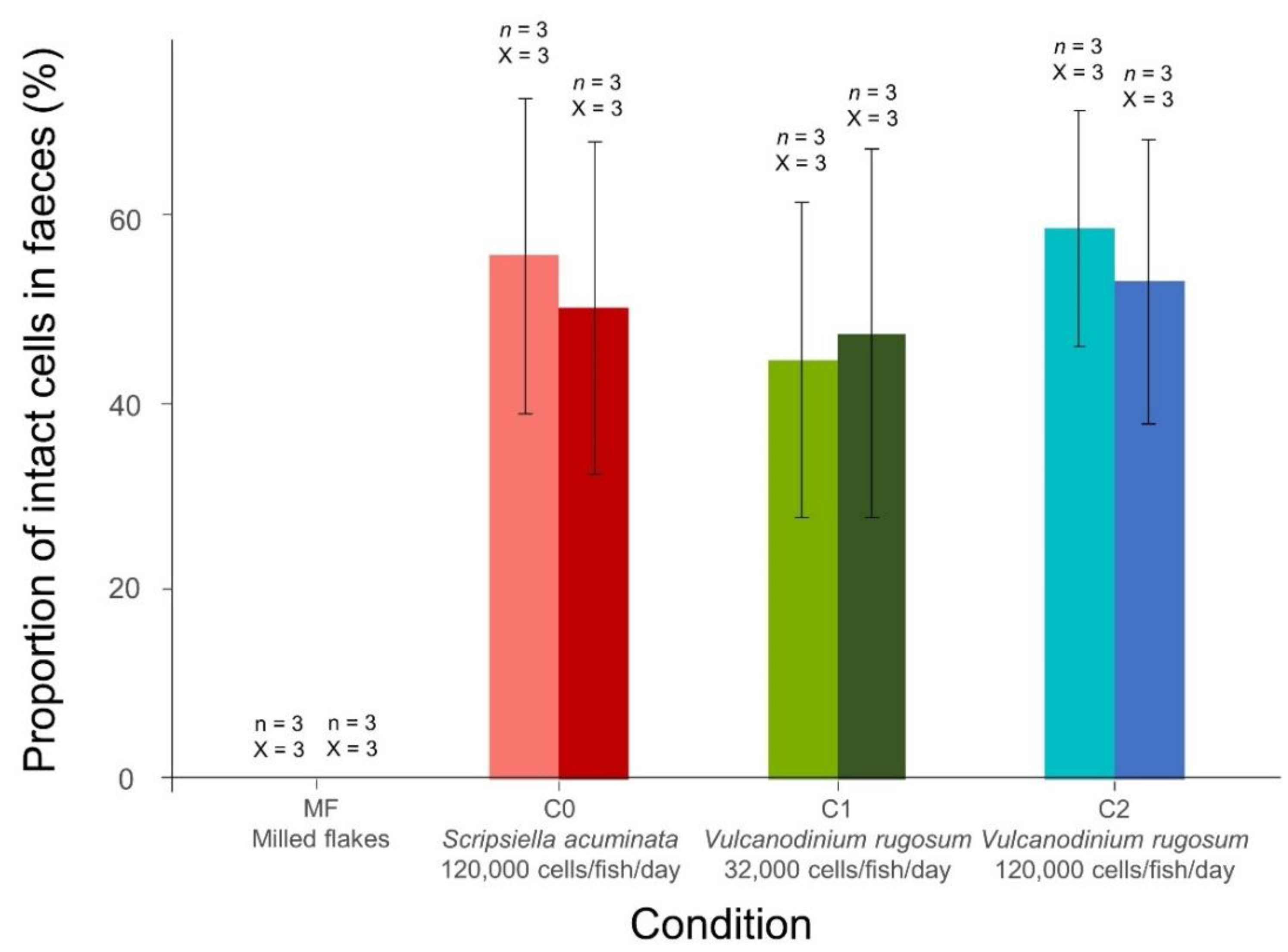
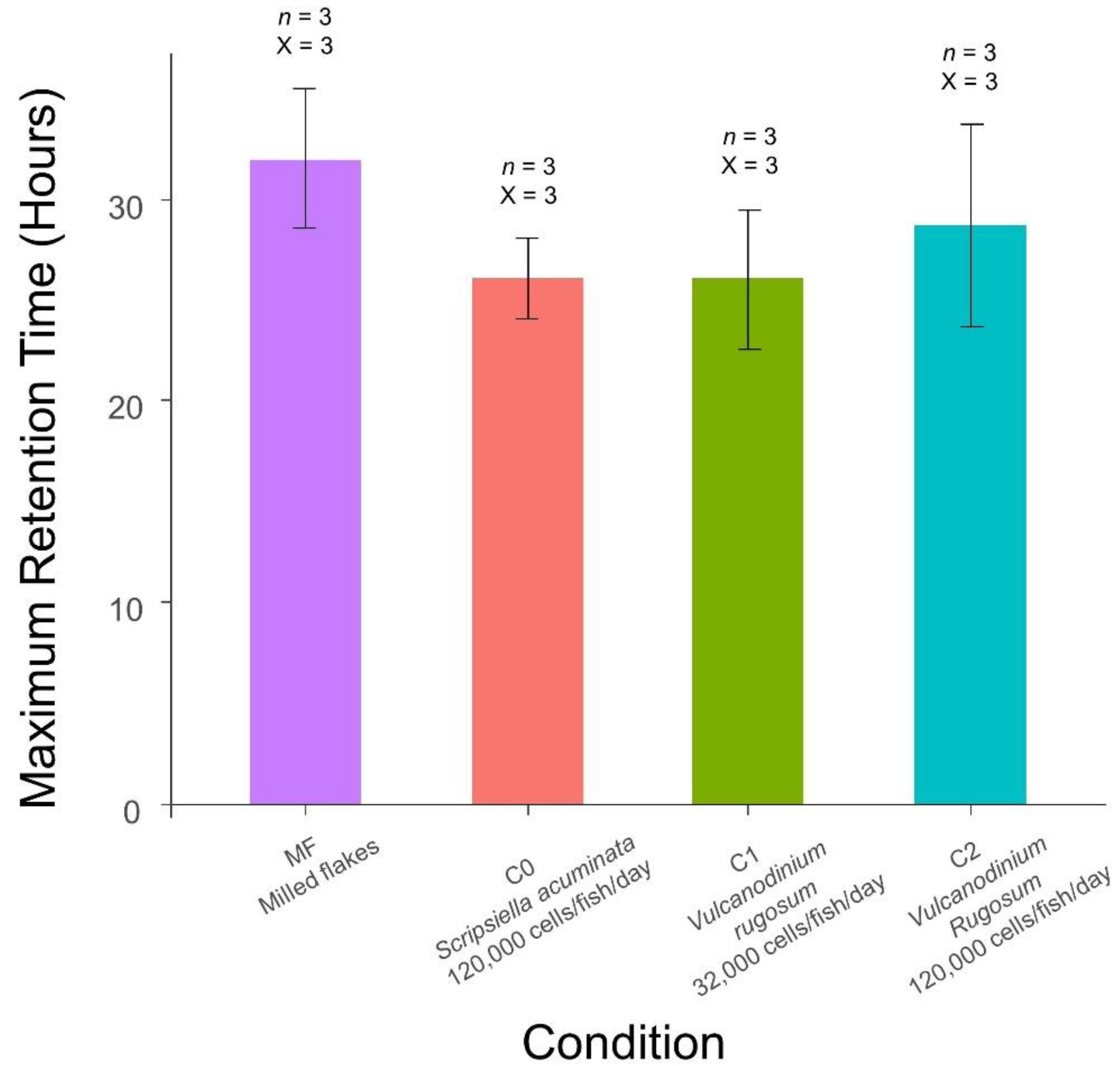
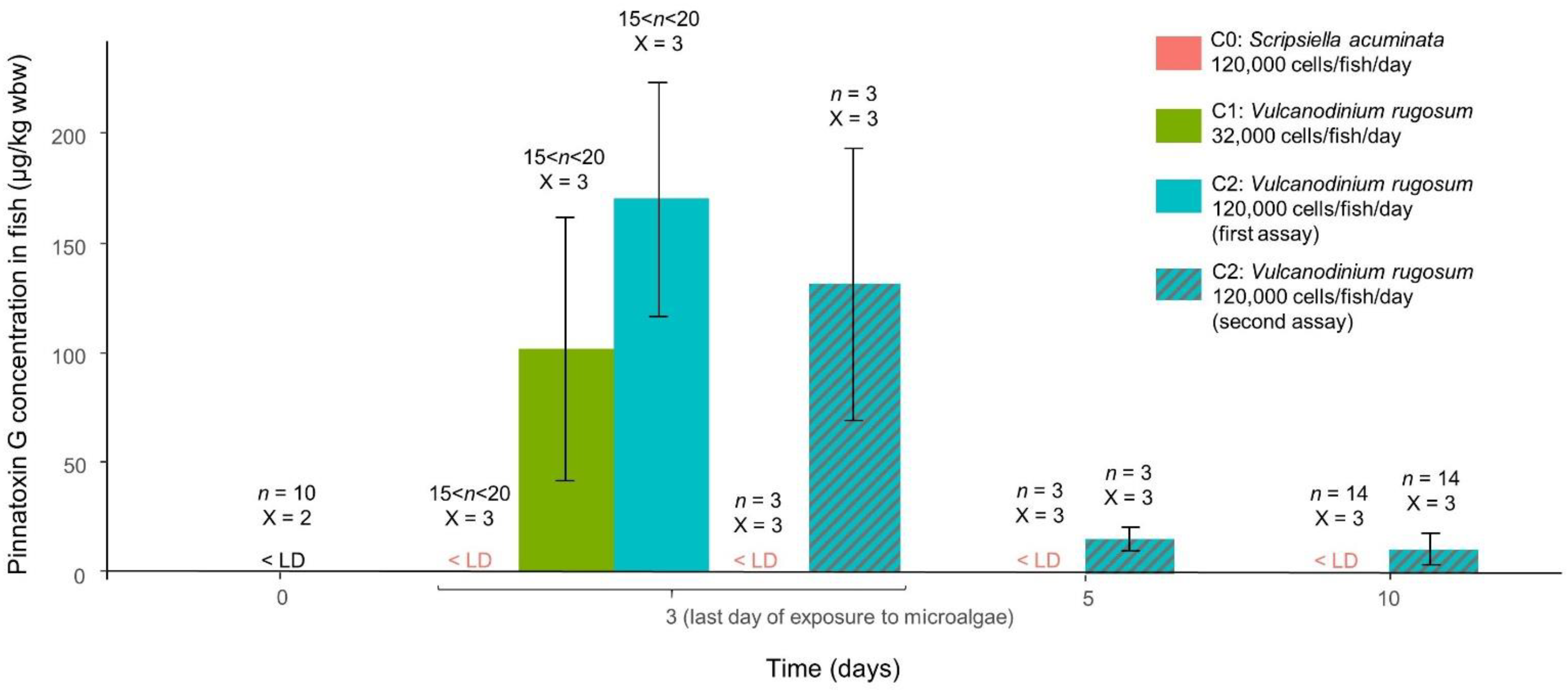

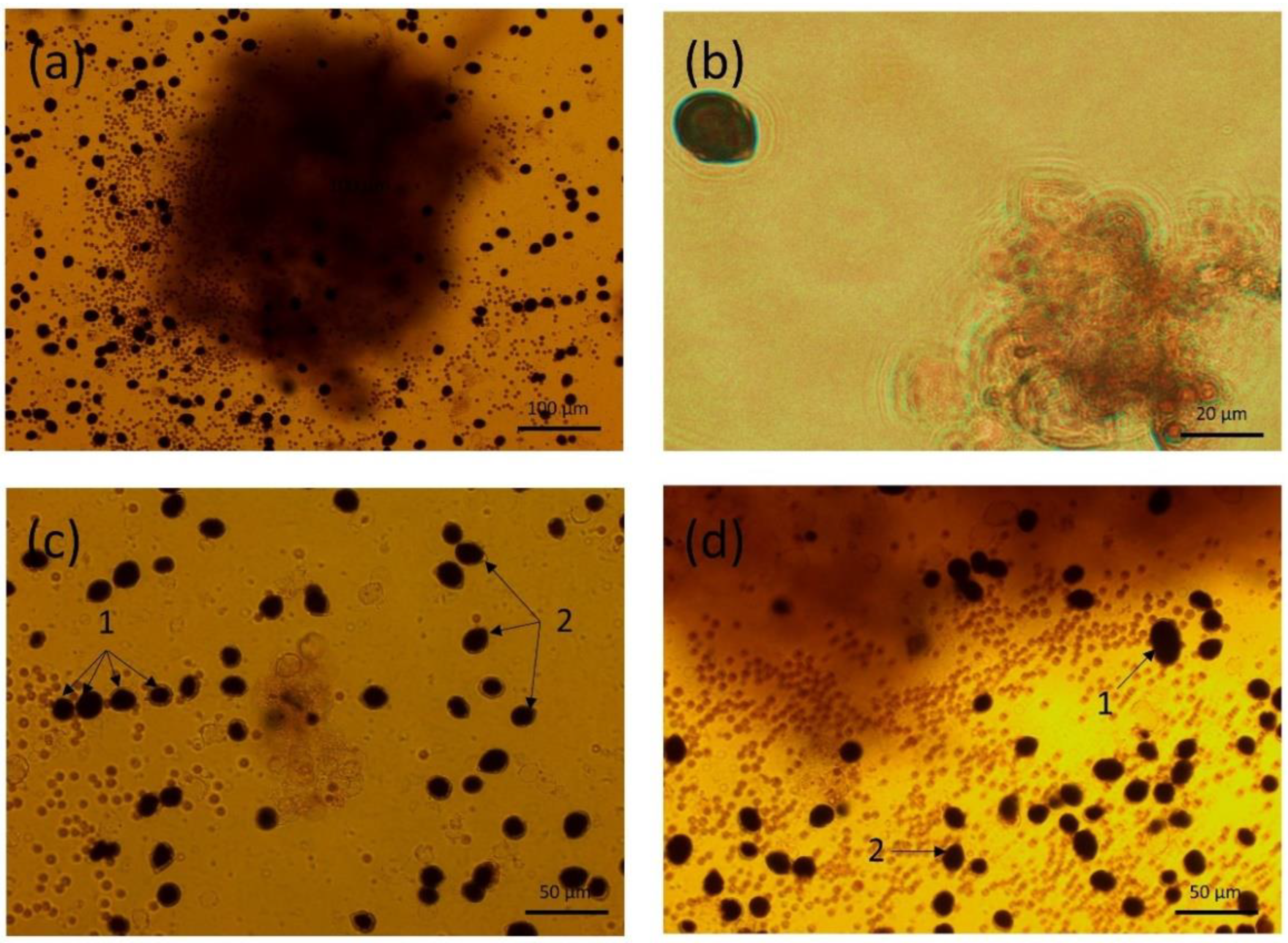
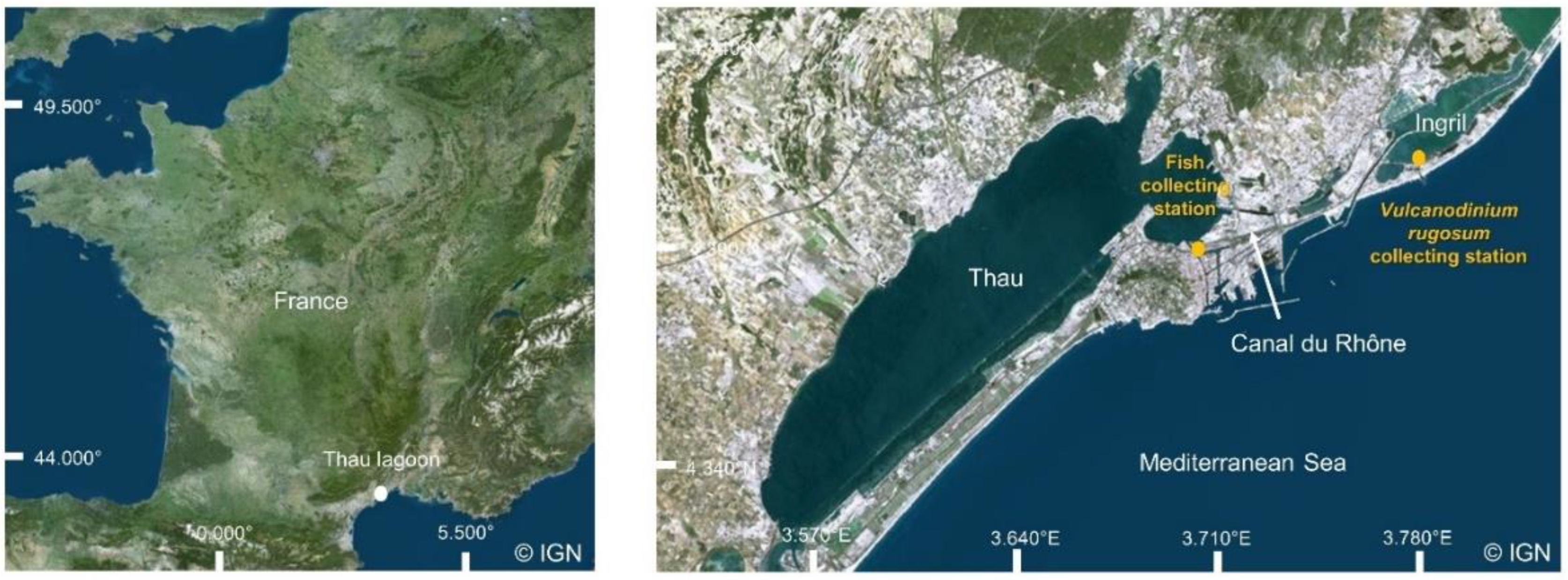
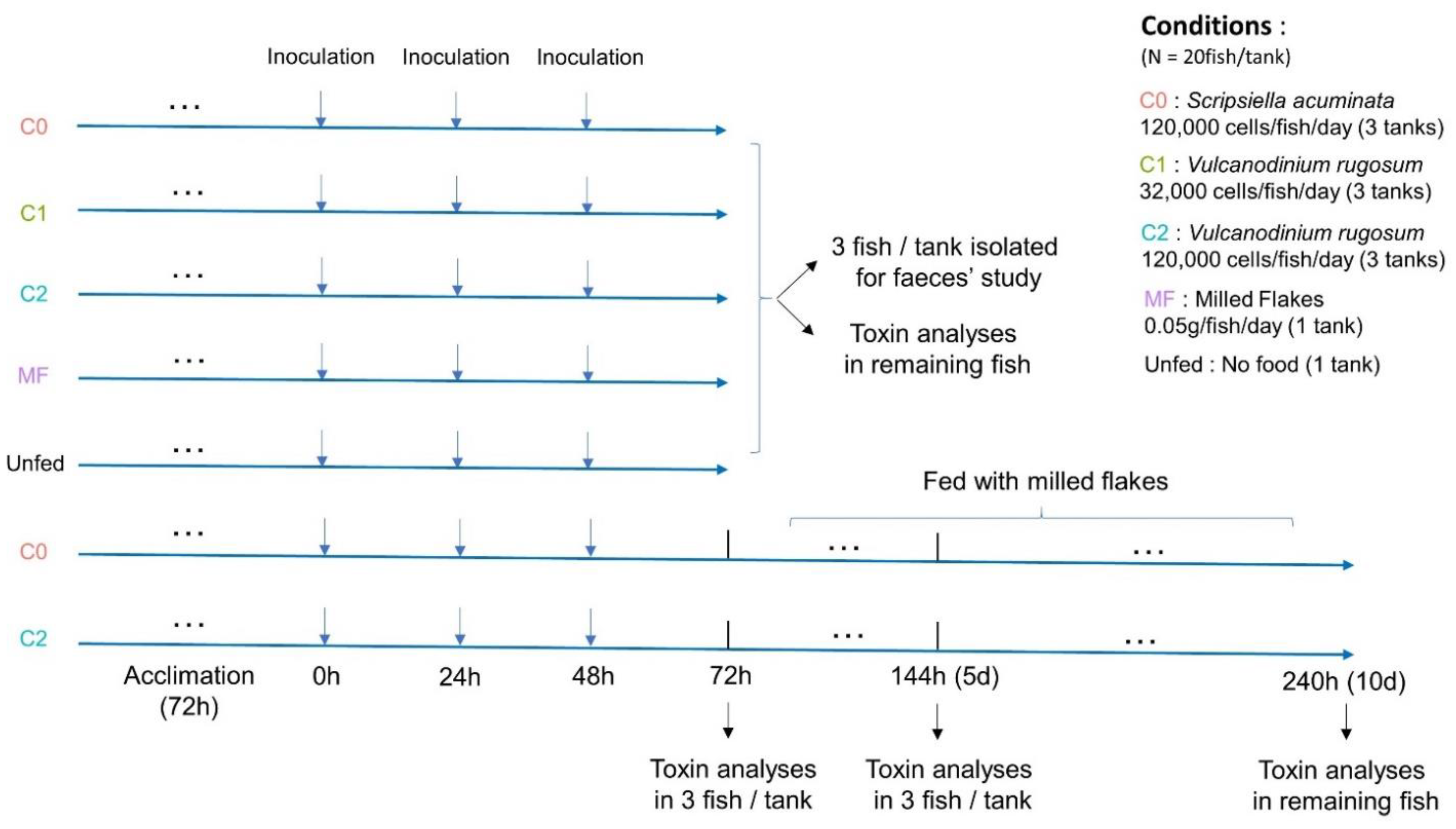
| Experiment | Days | ||||||
|---|---|---|---|---|---|---|---|
| Aquarium (20 Individuals per Aquarium at t0) | Food | Quantity of Food | 1 | 2 | 3 | 5 | 10 |
| Number of Deaths | |||||||
| Unfed | - | - | 0 | 0 | 0 | - | - |
| Milled flakes | Milled Flakes | 0.05 g/fish/day | 0 | 0 | 0 | - | - |
| C0.1 | Scripsiella acuminata | 120,000 cells/fish/day | 0 | 0 | 0 | - | - |
| C0.2 | 0 | 0 | 1 | - | - | ||
| C0.3 | 0 | 0 | 0 | - | - | ||
| C0.4 | 0 | 0 | 0 | 0 | 0 | ||
| C0.5 | 0 | 0 | 0 | 0 | 0 | ||
| C0.6 | 0 | 0 | 0 | 0 | 0 | ||
| C1.1 | Vulcanodinium rugosum | 32,000 cells/fish/day | 0 | 0 | 2 | - | - |
| C1.2 | 0 | 0 | 1 | - | - | ||
| C1.3 | 0 | 0 | 0 | - | - | ||
| C2.1 | Vulcanodinium rugosum | 120,000 cells/fish/day | 0 | 0 | 0 | - | - |
| C2.2 | 0 | 0 | 1 | - | - | ||
| C2.3 | 0 | 0 | 0 | - | - | ||
| C2.4 | 0 | 0 | 0 | 0 | 0 | ||
| C2.5 | 0 | 0 | 0 | 0 | 0 | ||
| C2.6 | 0 | 0 | 0 | 0 | 0 | ||
| Microalga Species | Cells Concentration in Aquaria (Cells/Fish/Day) | RTmax (h) | Proportion of Intact Cells (%) | Time before Germination (h) | |
|---|---|---|---|---|---|
| 2 to 10 h | 24 to 34 h | ||||
| Scripsiella acuminata | 120,000 | 32 ± 3.5 | 55.6 ± 16.7 | 50.0 ± 17.7 | - |
| Vulcanodinium rugosum | 32,000 | 26 ± 2 | 44.4 ± 16.7 | 47.2 ± 19.5 | 8 to 22 |
| 120,000 | 26 ± 3.5 | 58.3 ± 12.5 | 52.8 ± 15.0 | 8 to 22 | |
Publisher’s Note: MDPI stays neutral with regard to jurisdictional claims in published maps and institutional affiliations. |
© 2022 by the authors. Licensee MDPI, Basel, Switzerland. This article is an open access article distributed under the terms and conditions of the Creative Commons Attribution (CC BY) license (https://creativecommons.org/licenses/by/4.0/).
Share and Cite
Bouquet, A.; Perdrau, M.A.; Laabir, M.; Foucault, E.; Chomérat, N.; Rolland, J.L.; Abadie, E. Liza ramada Juveniles after Exposure to the Toxic Dinoflagellate Vulcanodinium rugosum: Effects on Fish Viability, Tissue Contamination and Microalgae Survival after Gut Passage. Toxins 2022, 14, 401. https://doi.org/10.3390/toxins14060401
Bouquet A, Perdrau MA, Laabir M, Foucault E, Chomérat N, Rolland JL, Abadie E. Liza ramada Juveniles after Exposure to the Toxic Dinoflagellate Vulcanodinium rugosum: Effects on Fish Viability, Tissue Contamination and Microalgae Survival after Gut Passage. Toxins. 2022; 14(6):401. https://doi.org/10.3390/toxins14060401
Chicago/Turabian StyleBouquet, Aurélien, Marie Anaïs Perdrau, Mohamed Laabir, Elodie Foucault, Nicolas Chomérat, Jean Luc Rolland, and Eric Abadie. 2022. "Liza ramada Juveniles after Exposure to the Toxic Dinoflagellate Vulcanodinium rugosum: Effects on Fish Viability, Tissue Contamination and Microalgae Survival after Gut Passage" Toxins 14, no. 6: 401. https://doi.org/10.3390/toxins14060401
APA StyleBouquet, A., Perdrau, M. A., Laabir, M., Foucault, E., Chomérat, N., Rolland, J. L., & Abadie, E. (2022). Liza ramada Juveniles after Exposure to the Toxic Dinoflagellate Vulcanodinium rugosum: Effects on Fish Viability, Tissue Contamination and Microalgae Survival after Gut Passage. Toxins, 14(6), 401. https://doi.org/10.3390/toxins14060401





